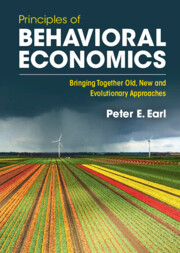Book contents
- Principles of Behavioral Economics
- Principles of Behavioral Economics
- Copyright page
- Contents
- Figures
- Tables
- Preface
- Acknowledgments
- 1 What Is Behavioral Economics?
- 2 What Motivates Us?
- 3 Why Is Life So Full of Problems for Us to Try to Solve?
- 4 How Do We Acknowledge Problems and Assess Options?
- 5 How Do We Deal with Uncertainty and Ambiguity?
- 6 How Do We Search for Solutions to Problems?
- 7 Why Do Some Things Matter More Than Others?
- 8 How Do We Choose?
- 9 How Can Firms and Governments Influence Our Choices?
- 10 What Determines the Productivity of an Organization?
- 11 How Does the Competitive Process Work?
- 12 Are There Any Behavioral Insights for Macroeconomists?
- 13 Can We Be Happy without Destroying the Environment?
- References
- Index
13 - Can We Be Happy without Destroying the Environment?
Published online by Cambridge University Press: 18 October 2022
- Principles of Behavioral Economics
- Principles of Behavioral Economics
- Copyright page
- Contents
- Figures
- Tables
- Preface
- Acknowledgments
- 1 What Is Behavioral Economics?
- 2 What Motivates Us?
- 3 Why Is Life So Full of Problems for Us to Try to Solve?
- 4 How Do We Acknowledge Problems and Assess Options?
- 5 How Do We Deal with Uncertainty and Ambiguity?
- 6 How Do We Search for Solutions to Problems?
- 7 Why Do Some Things Matter More Than Others?
- 8 How Do We Choose?
- 9 How Can Firms and Governments Influence Our Choices?
- 10 What Determines the Productivity of an Organization?
- 11 How Does the Competitive Process Work?
- 12 Are There Any Behavioral Insights for Macroeconomists?
- 13 Can We Be Happy without Destroying the Environment?
- References
- Index
Summary
This final chapter applies material from earlier chapters in the context of ecological economics and happiness economics. From the former it accepts that natural resource limitations (including capacities for storing waste products without harming the biosphere) require growth in per-capita incomes in advanced economies to be reined in, so the chapter focuses on how this can be done without making affluent consumers miserable. The type of change needed is shown via vignettes of materialistic and green lifestyles, bringing out the need to adopt more mindful ways of living and for society to make social standing a function of the contributions people make to social and environmental well-being rather than how wealthy or powerful a person is. Resistance to change is explored both in cognitive terms and in relation to the shortcomings of complex systems (e.g., transportation systems) in terms of missing links or prerequisites. However, since the book’s analysis is not based on fixed preference systems and it applies the idea of brain plasticity being an inherent consequence of thinking, the key thing is whether people will be able to change before environmental tipping points are reached.
Keywords
- Type
- Chapter
- Information
- Principles of Behavioral EconomicsBringing Together Old, New and Evolutionary Approaches, pp. 430 - 469Publisher: Cambridge University PressPrint publication year: 2022

